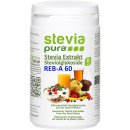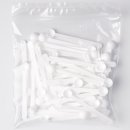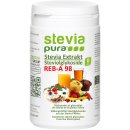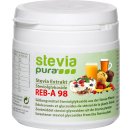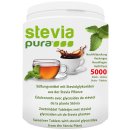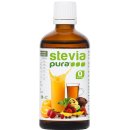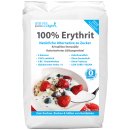Stevia Seeds | Stevia rebaudiana | Sweet Leaf Herb | 1 x 100 Seeds
Can you grow Stevia yourself?
The perennial plant Stevia rebaudiana, also known as Sweet Leaf, has been used for centuries in South America as a sweetener and medicinal plant. Stevia is considered an ideal alternative to sugar and conventional sweeteners. The sweetening power of its leaves is around 30 times that of conventional household sugar, yet it contains no calories. In contrast to sugar, stevia also has no caries-promoting properties. The plant is also ideal for diabetics as it does not affect blood sugar levels.
Is the Stevia plant hardy?
The undemanding perennial, which reaches a height of around 50 to 80 centimetres, thrives best in a pot. Although the Stevia plant is perennial, it is not frost-hardy. For this reason, the Stevia plant should spend the winter in a cool place on a windowsill and only be planted in the garden again in spring. Delicate leaves grow on the flexible, hairy shoots and white flowers appear at the tips of the shoots in autumn.
What do I do with the Stevia plant?
Stevia should be used sparingly in the kitchen due to its particularly high sweetening power. Dried leaves can be crumbled and used to sweeten hot tea or cold drinks. The crushed leaves of the Stevia plant are also suitable for sweetening desserts.
PRODUCT SPECIFICATION
Stevia Seeds | Stevia rebaudiana | Sweet Leaf Herb | 1 x 100 Seeds
Product name: Stevia rebaudiana seeds | sweet leaf herb (seeds)
Number of seeds: approx. 100 seeds
Storage instructions: Cool and dry
The leaves of the Stevia plant from South America contain an extremely effective natural sweetener that is up to 300 times sweeter than sugar. It has virtually no calories and does not cause tooth decay.
For centuries, the indigenous people of South America have used Stevia to sweeten their food and drinks. The plant is also used as a traditional sweetener for mate.
Although Stevia grows easily in Europe, it is usually cultivated as an annual. It requires a warm and extremely sunny location as well as moderate watering. Periods of dryness and humidity are favourable for the plant's well-being.
Characteristics & Care
|
Plant Family: |
Asteraceae |
|
Height of the plant: |
approx. 80-100 cm |
|
Flowering time: |
October to December |
|
Flower colour: |
White |
|
Lifespan: |
Annual to perennial |
|
Sunlight: |
Sun |
Sowing & Cultivation
|
Sowing in pre-culture (pre-growing plants): |
April-May |
|
Sowing depth when sowing: |
0 cm* |
|
Optimum temperature for germination: |
22 – 25 °C |
|
Germination time in days: |
Depending on temp. |
|
Planting distance: |
40 x 40 cm |
|
Special features: |
*Light germinator |
|
Harvest: |
All year round |
Growing your own Stevia from seed is uncomplicated: As Stevia is a light germinator, it is sufficient to sprinkle the seeds lightly on the sowing soil and press them down lightly. It is important not to cover the seeds with soil, as light is crucial for the germination process. After sowing, the seeds should be lightly watered. Patience is required as it can take up to two weeks for the seeds to germinate. During this time, they should be kept in a warm place; temperatures above 20 degrees Celsius are ideal.
As soon as the seedlings have grown a little, they can be transplanted into separate pots. Stevia prefers rather dry conditions, so it is advisable not to water it too often. Stevia is not hardy, so it should spend the winter indoors in frost-free conditions. It is important to place the plant in a bright spot and only water it very sparingly, about once a month.
Synonyms: sweet leaf herb, honey herb, sugar plant
How do I use fresh Stevia leaves?
Things to know and tips
Stevia leaves are the most original form of Stevia and are considered a purely natural product. Many people are unclear about how to process and use the leaves. However, there are many possibilities, which is why we would like to provide information on the use of Stevia leaves.
Processing Stevia leaves
Stevia leaves can be processed in different ways, depending on whether they are used fresh or dried. This depends on whether you have your own Stevia plant or whether you buy the leaves already dried. The leaves can be used as they are to sweeten tea or to make a sweet infusion (brewing time approx. 10 minutes). Alternatively, they can be ground into powder in a mortar and used to sweeten food and drinks. The crushed Stevia leaves can also be used in cooking by finely chopping them.
Using Stevia leaves correctly
It can therefore be seen that the use of Stevia leaves is very versatile. However, a certain amount of prior knowledge is recommended when using Stevia leaves, as otherwise the dosage is difficult and an unpleasant aftertaste is quickly achieved. Depending on how the Stevia leaves are processed, they can be used in different ways.
Unprocessed, they are suitable for making a sweet infusion or decoction and can also simply be added to tea. When ground, they can be used in baking. However, special recipes should be used here, as Stevia powder has a much smaller volume than sugar. Finely chopped Stevia leaves can be used to sweeten fruit sauces, puddings or salads.
The optimum dosage of Stevia leaves
A good flavour experience is only achieved if the Stevia leaves are dosed correctly. However, many people do not know how much is enough to bake a cake or sweeten a cup of tea, for example. Individual taste plays a role here, and a feeling for the optimum dosage of leaves develops over time.
A rough rule of thumb is that 0.5 g of stevioside, the concentrated extract of Stevia, per 1 litre of liquid is sufficient. This corresponds to approximately 0.8 g of dried Stevia leaves. The quantity can of course vary depending on the Stevia plant, whereby the concentration of stevioside can vary. It should be noted that the sweetness of the stevioglycosides does not increase with increasing concentration, but a bitter aftertaste can develop. It is therefore advisable to use special recipes with Stevia for baking. This takes volume fluctuations into account and saves the time-consuming conversion of conventional recipes.
Although the use of Stevia leaves may not be entirely straightforward and requires some practice, it allows this natural product to be used in a variety of ways. It is therefore an alternative to conventional sugar.

